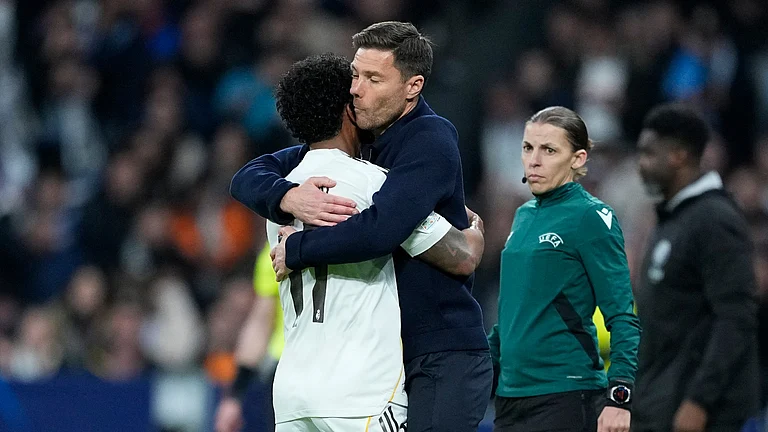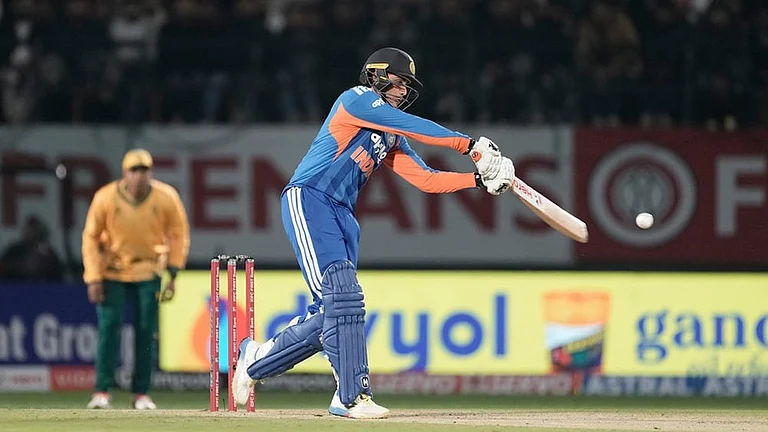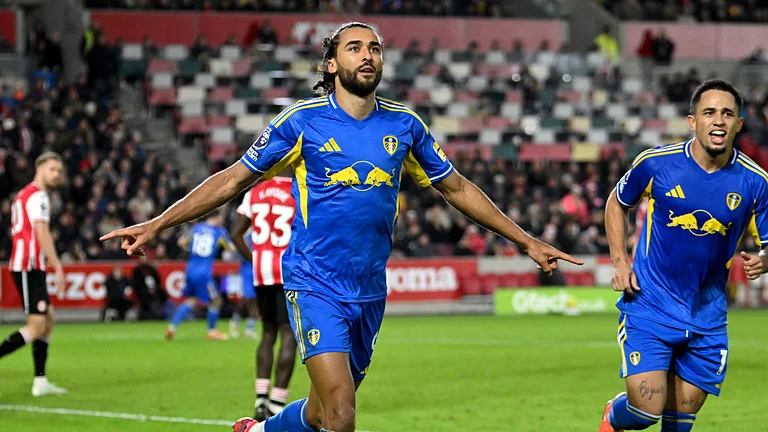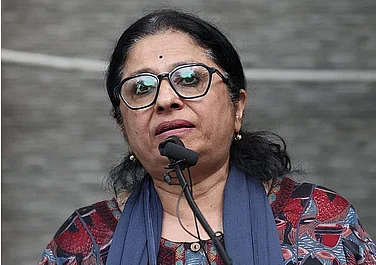“Life imitates art far more than art imitates life”
- Oscar Wilde In The Decay of Lying
The 2022 French film ‘Athena’ opens with a tense scene where an Algerian-French soldier Abdel is seen addressing a press conference in France, confirming that his 13-year-old brother Idir had been killed after a police beating. As Abdel tries to pacify the restive crowd - composed largely of immigrants and people of colour - his angrier brother Karim hurls a Molotov cocktail at the group and the rest of the plot descends into chaos.
Abdel, Karim and Idir are residents of a French ‘banlieue’ (French for ‘suburb’, often used as a pejorative against immigrants and ‘outsiders’) named Athena where director Romain Gavras’ Greek tragediesque political thriller and social commentary plays out, giving a glimpse of the ‘other’ France and the living contradictions of the so-called ‘egalitarian’ French society.
The storyline of ‘Athena’, a year later, has become a prophecy for what is unfolding in France in 2023 after the death of the 17-year-old Nahel, an Algerian teenager from a Parisienne banlieue named Nanterres. Nahel was allegedly killed at point-blank range by French Police at a traffic checkpoint, the latest of the 17 similar fatalities in France in the past 18 months.
Much like in ‘Athena’, the killing of the underage Algerian-French boy from Nanterres has triggered anger, protests and even instances of violence in France. The anger, which exploded with a vengeance six days ago and held large parts of France and its people hostage in its wrath, has left a trail of violence and wreckage. But worse still, it has left the two Frances even more divided, even more alienated.
The ‘other’ France
Gavras’ ‘Athena’ shows France that lies beyond the beige-tinted Parisienne cafes which once birthed “revolution” and the provincial gardens and palaces gilded with the indulgent afterthought of secularism. It is France that lives in cloistered suburbs made of brutalist housing quarters meant to house the working class, relegated to the outskirts of Paris. Singled out and shunned from the ‘French’ majority, this France is restive, alienated, poor, angry and, for the most part, invisible.
This invisible France is a microcosm of the world, inhabited mainly by poor, working-class residents and people of foreign origin mainly from former French African colonies. These people migrated to these suburbs from the 1950s-70s in search of work and the banlieues were built for the very purpose of having the working class handy for taking care of the needs of the rich in Paris.
These include French people from rural areas as well as immigrants of Arab and African descent. There is a mix of religions including Judaism, Christianity, and Islam, the latter being in the majority. The recent clashes across France have brought these banlieues back into focus. While they remain a vibrant mix of cultural identities, a true expression of French cosmopolitanism, they bear the brunt of France’s self-proclaimed brand of secularism.
The setting and plotline of Gavras’ Athena sharply bring out the schism between the two Frances, not unlike the way the recent killing of Nahel has done for the nation, which often finds itself divided between its centuries-old rumination between far left and far right.
The immigrant communities – the distinctive ‘other’ of French society, the people of colour in a self-assumed “colourblind” nation – see the killing of Nahel as a mark of impunity upon the ever-increasing assault and discrimination faced by them at the hands of the brutal French police. Many, like the fictitious Karim from Athena, seem to believe that violence is the only means to justice.
Meanwhile, news headlines have been proclaiming that the ‘people of France’ are coming out in rallies against the rioters. It raises two questions. Who are the “people of France” and who are the “rioters”? Or protesters, depending on the political leanings of the observer? Nevertheless, French people have rallied in solidarity with local governments after rioters attacked and ransacked houses of local mayors, even endangering the lives of their families. Since the killing, a GoFundMe account for the police officer who shot Nahel has raised thousands in donations. Thousands across France seemingly believe that the police officer, now in custody for homicide, is being unfairly targeted for doing his job.
Between Right And Far Right
In the aftermath of the Nahel shooting, French President Emmanuel Macron has come down hard on French police in a move that is uncharacteristic of the country that relies on the police to enforce its laws on citizens. Which the police do, often with brute force. “Nothing justifies the death of a young person,” Macron said, referring to the actions of the police as “inexcusable” and “inexplicable.” But it was perhaps Nahel’s grandmother, who recently spoke against the violence that had gripped the nation, and requested the rioters to give up violence, that the raw anger abated, even if a bit. She said that miscreants were misusing her grandson’s name to cause violence.
The incident nevertheless sheds a spotlight on the crossroads that the immigrant communities of France find themselves in, just like the characters of Athena. In the film, even though Abdel is a police officer, he is arrested because he is suspected of helping the mob, despite his record of serving his nation in Mali. His allegiance is judged based on his ethnicity. The contradictions within the immigrant population come sharply to the fore when a group of youths from Athena capture a young cop, Jerome, the runt of the police squad that came to raid Athena at night. In exchange for his release, the group which includes Karim, demands the names of the three policemen who had beaten young Idir to death. It is Abdel who rescues Jerome and tries to send him back to the authorities. In the process, he loses Karim who is shot by some corrupt cops. An angry Abdel then loses all judgement and kills a crook (who also was his relative) and seems to turn on Jerome, threatening to kill him. In the end, he lets Jerome go in time before police forces blow up the cabin in which Abdel and Jerome had taken shelter inside Athena. By the end, all three brothers had been killed.
The film reveals the often unacknowledged stratifications in French society at large as well as within the immigrant communities living in these cut-off industrial estates that struggle with the problem of youth unemployment and racial discrimination at the hands of police which further fuels crime and drugs. It also brings to light the contradictions within the immigrant society itself. Much like the law-abiding Abdel and the emotional Karim, reacting to the killing of their brother, the residents of banlieues find themselves at the crossroads of their ethnic identities and French nationality. They demand to be seen and their angst heard by a nation as much theirs, even as they struggle to hold on to their cultural roots in a society that refuses to adapt to them.
But the world is watching and it is once again upon the community (not unlike the residents of Athena), to prove itself worthy of being protected by the police, and not attacked. It depicts realistically the antagonistic relationship that large sections of the French population have with the police, a tool of punitive governance rather than justice for citizens.
Since the violence, European media, especially that in Britain and the US, has been deliberating on how Macron needs to find a middle path of mediation between both these sides: the “anger and resentment simmering in communities on the margins”, as quoted by Guardian in a recent article and the majoritarian and “far right” sentiment which, under the leadership of Macron’s nemesis Marine La Pen, had caused considerable concerns to Macron in the 2020 French elections.
Despite being a self-proclaimed centrist with roots in left politics, Macron and his government have long straddled accusations of Islamophobia, anti-immigrant policies and increasing authoritarianism. His government has repeatedly failed to address or condemn the rising number of attacks by far-right groups across French urban centres like Paris, Lyon, Strasbourg and Nantes in recent years. The President also did not condemn sledging and death threats against hard-left leaders and intellectuals in 2021, though he had personally called a popular right-wing ideologue to convey his niceties after said leader faced a verbal attack on the streets.
Studies show that despite its apparent secularism and “colour-blindness”, French society can be deeply racist. People of black or North African descent, especially the youth, are 20 times more likely than white French people, to be stopped by police and asked to show their ID. Census data or other official data, however, fails to give a clear picture of the scale or intensity of the disadvantage faced by these communities due to the lack of details like race, ethnicity, skin colour in official forms, owning to France’s allegiance to so-called “colourblind” secularism.
Critics claim that Macron has politically exploited the emergence of the far right for his own gains, thus further alienating communities that have traditionally been represented by socialist or leftist politics.
From La Haine to Athena

The issues faced by French immigrants, however, are not one that is new to the Macron government. The French suburbs, counterparts of the American ‘projects’ for African American populations, have been an enduring subject for filmmakers in France, known for its realism in art and literature
The plot of Athena is similar to another iconic French film - the gritty and critically acclaimed 1995 cult classic La Haine, which told a similar story. It depicted three youths including an Arab, a Jew and a black man, all friends of another young Arab man from the same suburb as their - their peer - is beaten unconscious by the police, leading to unrest in the suburbs. The film centres around the incident and how it impacts young and conflicted minds of the disadvantaged immigrant populations living in these banlieues.
Speaking in an interview later, the film’s photographer Gilles Favier had stated that digitally, when he heard of the story, he had his doubts about whether an Arab, a Jew and a Black person would be friends in the first place. But his aspersions seem more recent. Eventually, he came to believe that “La Haine was about friends and maybe some hope. Nowadays I think you could only make a film about despair.”
Despite the tragedy unfolding on the screen, the creators of La Haine seem to assure that there is always a way out. Nearly three decades later, Athena and the subsequent shooting of Nahel are reminders of the futility of that hope. Unlike La Haine, there is no room for debate this time. The three brothers of Athena are definitely dead.
Athena, surely, is more despairing than La Haine, if not as searing, as is the time in which it has been shot and released. The divisions in French society are perhaps far worse than those in the France of the 90s. One of the key changes, perhaps, between the France that watched La Haine and the France that watched Athena, is the films’ endorsement by those in power. While both the films have their finger on the pulse of the social malaise that plagues France, La Haine enjoyed approval from the government with then Prime Minister Alain Juppé even asking for the film to be screened for government officials. This is despite police personnel turning their backs on an international screening of the film as a mark of protests against the “anti-police” film. Will Macron make Athena a compulsory watch for his cabinet and government employees?
Perhaps he should. Clips from ‘Athena’ have gone viral as fake footage from the ongoing protests. A viral image shows protesters in France leaning out of a police van as it speeds down a road amid the protests. The image is not a real moment but a still from the film. Fact and fiction seem to have mingled.
The film ‘Athena’ ends with a video of the incident of the killing. It shows three men - belonging to the far right - donning police uniforms and beating Idir. The entire incident turns out to be a hoax by right-wing extremists wanting to stir racial trouble. In doing so, the film’s director perhaps chooses a sort of middle ground between the police and the rioters, humanising and dehumanising both. It seems to leave the audience in a comforting meditation about radicalism on both sides.
It does not have a hopeful ending but rather ends on a note of acrid digital paradox where one is left wondering that very old question - is art imitating life or life imitating art?


























